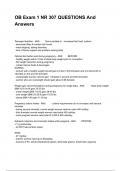OB Exam 1 NR 307 QUESTIONS And
Answers
Teenager Nutrition - ANS Teens partake in: - increased fast food, sodium
- decreased fiber & nutrient rich foods
- meal skipping, eating disorders
- lack of family support and problem solving skills
Optimal diet before and during pregnancy - ANS BEFORE
- healthy weight within 15 lbs of ideal body weight prior to conception
- NO weight reduction during pregnancy
- nutrient dense foods & beverages
DURING
- women with a healthy weight should gain 2-4 lbs in first trimester and 3-4 lbs/month or
1lb/week in 2nd and 3rd trimester
- underweight women need to gain 1 lb/week in second and third trimester
- women who are overweight should gain about 0.66 lb/week
Weight gain recommendations during pregnancy for single baby - ANS - Ideal body weight
(BMI 18.5-24.9) gain 25-35 lbs
- under weight (BMI <18.5) gain 28-40 lbs
- over weight (BMI 25-29.9) gain 15-25 lbs
- obese (BMI >30) gain 11-20 lbs
Pregnancy caloric intake - ANS - calorie requirements do not increase until second
trimester
- during second trimester, normal weight women need an extra 340 cal/day
- third trimester normal weight women need extra 450 cal/day
- most pregnant women need total of 2,200-2,900 cals/day
Nutrients (vitamins and minerals) Intake while pregnant - ANS PROTEIN
-71 g protein/day
- do NOT take protein supps.
IRON
- 27 mg/day
- anemic women need up to 60mg/day
- sources of Fe: whole wheat/whole grains, dark leafy greens, dried fruits, legumes
,CALCIUM
- good sources: yogurt, almonds, milk, cheese
- soy & reg milk good; coconut milk not good source
FOLATE
- need 0.4mg/day or 400 mcg/day PRIOR to pregnancy
- need 600-800 mcg DURING pregnancy
- sources: beans, fruits, enriches grains, water soluble vitamin
- folate reduces the chance of neural tube defects (spina bifida)
Foods to avoid during pregnancy - ANS - artificial sweeteners with aspartame
- unsaturated fats
- excessive sodium
- no alcohol
- limit caffeine to 200mg/day
- Mercury containing seafood: shark, sword fish, king mackerel, tile fish, big-eyed tuna
- limit seafood to 12oz/week and limit albacore to 6oz/week
Pica - ANS compulsive eating of non-food substances such as clay or ice
how to avoid listeria - ANS -use pasteurized foods, avoid raw/undercooked meats, avoid
certain cheeses, heat leftovers completely, prepare and store food safely
- Listeria may cause miscarriage in first trimester, premature labor, infant with a LBW, or fetal
infections
- avoid hot dogs, lunch meats, soft cheeses like feta, refrigerated smoked seafood
Toxoplasmosis - ANS a parasite that is most commonly transmitted from pets to humans by
contact with contaminated animal feces (cat litter box), raw/undercooked food, or contaminated
water
heart burn and constipation prevention - ANS Heartburn- sit up after meals, avoid spicy
foods
Constipation- exercise, add more fiber to diet, avoid dairy
morning sickness - ANS - Nausea/vomiting during the first few months of pregnancy due to
increased estrogen and progesterone
- Typically goes away after the first trimester but in some cases may last months or the whole
pregnancy
- Usually does not harm fetus unless mother is unable to keep anything down causing weight
loss. Also interferes with day to day life
- Hyperemesis Gravidarum: most severe form of nausea and vomiting during pregnancy.
Treatment is crucial to replenish body from dehydration. Hospitalization is sometimes needed
- Nutritional advice to help with morning sickness: dry starchy foods, avoid excessive fluids in
morning; drink later in day, eat small frequent meals, avoid sudden movement in the morning;
, rise slowly, get fresh air/exercise, avoid spicy food, try ginger-ale, eat more carbs and less fried
and fatty foods
standard of care - ANS the minimum level of competent care that a prudent nurse would
provide
high risk pregnancy - ANS Life or health of a mother and/or offspring is jeopardized or
threatened
- 500,000 high risk births out of 4 million yearly
- high risk examples: teen pregnancy, geriatric pregnancy (35+)
Teen pregnancy complications - ANS - increased risk of still birth
- LBW (<5 lbs 8 oz aka 5.5 lbs or 2500 grams)
- VLBW (3.3 lbs or 1500 grams)
- increased risk of prematurity
- increased risk of birth trauma
maternal mortality rate - ANS number of maternal deaths from start of pregnancy through 6
weeks after delivery (42 days) per 100,000 live births
- Maternal mortality risk factors: age, lack of prenatal care, low education, unmarried,
non-caucasian
US maternal death causes
1. HTN
2. PE
3. hemorrhage
Worldwide maternal death causes
1. HTN
2. Infection
3. hemorrhage
infant mortality rate - ANS The number of infant (0-12months) deaths per 1,000 live births.
- Risk factors to infant death: limited education, young age, unmarried, poverty, lack of prenatal
care, poor nutrition, smoking, alcohol, maternal health conditions.
IUGR (intrauterine growth restriction) - ANS Fetal undergrowth
- IUGR is often due to poor blood supply to the placenta making it so that the placenta cannot
provide proper nutrition
- Poor placental blood flow may be caused by lack of nutrition, syphilis, preeclampsia, diabetes,
maternal vascular issues
- to help increase blood flow: drink more fluids, eat more protein, do not lie on back. Lie on side.




